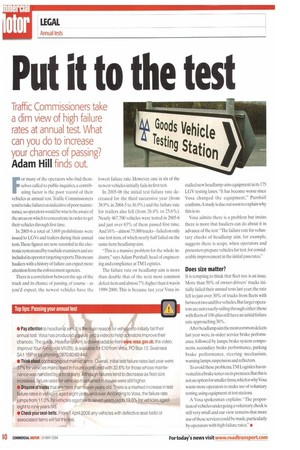Put it to the test
Page 40

If you've noticed an error in this article please click here to report it so we can fix it.
Traffic Commissioners take a dim view of high failure rates at annual test. What can you do to increase your chances of passing?
Adam Hill finds out.
For many of the operators who find themselves called to public inquiries, a contributing factor is the poor record of their vehicles at annual test. Traffic Commissioners tend to take failures as indicative of poor maintenance, so operators would be wise to be aware of the areas on which to concentrate in order to get their vehicles through first time.
In 2005-6 a total of 3,609 prohibitions were issued to LGVs and trailers during their annual tests These figures are now recorded in the electronic system used by roadside examiners and are included in operator targeting reports.This means hauliers with a history of failure can expect more attention from the enforcement agencies.
There is a correlation between the age of the truck and its chance of passing, of course — as you'd expect, the newest vehicles have the lowest failure rate. However, one in six of the newest vehicles initially fails its first test.
In 2005-06 the initial test failure rate decreased for the third successive year (from 38.9% in 2004-5 to 36.9%) and the failure rate for trailers also fell (from 26.4% to 25.6%). Nearly 467,700 vehicles were tested in 2005-6 and just over 63% of them passed first time. And 16% —almost 75,000 trucks—failed on only one test item, of which nearly half failed on the same item: headlamp aim.
"This is a massive problem for the whole industry," says Adam Purshall, head of engineering and compliance at TM Logistics.
The failure rate on headlamp aim is more than double that of the next most common defect item and almost 7% higher than it was in 1999-2000. This is because last year Vosa in stalled new headlamp-aim equipment in its 175 LG V testing lanes. "It has become worse since Vosa changed the equipment," Purshall confirms.A study is due out soon to explain why this is so.
Vosa admits there is a problem but insists there is more that hauliers can do about it in advance of the test: "The failure rate for voluntary checks of headlamp aim, for example, suggests there is scope. when operators and presenters prepare vehicles for test, for considerable improvement in the initial pass rates."
Does size matter?
It is tempting to think that fleet size is an issue. More than 50% of owner-drivers' trucks initially failed their annual tests last year; the rate fell to just over 30% of trucks from fleets with between two and five vehicles. But larger operators are not exactly sailing through either: those with fleets of 100-plus still have an initial failure rate approaching 30%.
After headlamp aim the most common defects last year were, in order: service brake performance, followed by lamps, brake system components, secondary brake performance, parking brake performance, steering mechanism, warning lamps,suspension and reflectors.
To avoid these problems,TM Logistics has invested in a brake tester on its premises. But this is not an option for smallerfirms,which is why Vosa wants more operators to make use of voluntary testing, using equipment at test stations.
A Vosa spokesman explains: "The proportion of vehicles undergoing a voluntary check is still very small and our view remains that more use of these services could be made,particularly by operators with high failure rates." •






















































































































































































